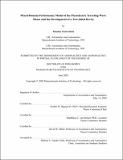| dc.contributor.advisor | Nesbitt W. Hagood, IV. | en_US |
| dc.contributor.author | Glenn, Timothy Scott, 1971- | en_US |
| dc.contributor.other | Massachusetts Institute of Technology. Dept. of Aeronautics and Astronautics. | en_US |
| dc.date.accessioned | 2005-05-19T15:07:18Z | |
| dc.date.available | 2005-05-19T15:07:18Z | |
| dc.date.copyright | 2002 | en_US |
| dc.date.issued | 2002 | en_US |
| dc.identifier.uri | http://hdl.handle.net/1721.1/16875 | |
| dc.description | Thesis (Ph. D.)--Massachusetts Institute of Technology, Dept. of Aeronautics and Astronautics, 2002. | en_US |
| dc.description | Page 226 blank. | en_US |
| dc.description | Includes bibliographical references (p. 221-225). | en_US |
| dc.description | This electronic version was submitted by the student author. The certified thesis is available in the Institute Archives and Special Collections. | en_US |
| dc.description.abstract | In recognition of the growing consideration of piezoelectric traveling-wave motors as suitable replacements for small-scale electromagnetic motors, the present work addresses two parallel objectives: (1) to develop an advanced modeling approach for the accurate prediction of steady-state performance of piezoelectric traveling-wave motors, and (2) to improve upon the typical piezoelectric traveling-wave motor configuration by investigating the novel implementation of two-sided operation. Firstly, a performance model of the piezoelectric traveling-wave motor has been developed that accounts for loss at the material level through the integration of complex material constants. In effect, all model parameters can be attributed to physically relevant properties, and, as demonstrated by the success of several experimental correlation studies, motor performance can be predicted independently of the measured characteristics of an existing device. Other key features of the model include a dynamic rotor model, a hysteretic stick-slip friction contact model, and generalization to accommodate non-ideal traveling-wave excitation. Critical to the cohesion of the model, a mixed-domain formulation combines the ease and accuracy of deriving the nonlinear contact forces in the time domain and the efficiency of equilibrating the modal forces in the frequency domain. | en_US |
| dc.description.abstract | (cont.) Secondly, a two-sided motor configuration has been developed that is theoretically capable of doubling the torque and power output of the typical configuration with little or no increase in size or mass. Controlled experimental testing has been performed concurrently on essentially identical one-sided and two-sided prototypes, and the results verify a dramatic performance improvement due to the implementation of two-sided operation. | en_US |
| dc.description.statementofresponsibility | by Timothy Scott Glenn. | en_US |
| dc.format.extent | 226 p. | en_US |
| dc.format.extent | 10223634 bytes | |
| dc.format.extent | 10222564 bytes | |
| dc.format.mimetype | application/pdf | |
| dc.format.mimetype | application/pdf | |
| dc.language.iso | eng | en_US |
| dc.publisher | Massachusetts Institute of Technology | en_US |
| dc.rights | M.I.T. theses are protected by copyright. They may be viewed from this source for any purpose, but reproduction or distribution in any format is prohibited without written permission. See provided URL for inquiries about permission. | en_US |
| dc.rights.uri | http://dspace.mit.edu/handle/1721.1/7582 | |
| dc.subject | Aeronautics and Astronautics. | en_US |
| dc.title | Mixed-domain performance model of the piezoelectric traveling-wave motor and the development of a two-sided device | en_US |
| dc.type | Thesis | en_US |
| dc.description.degree | Ph.D. | en_US |
| dc.contributor.department | Massachusetts Institute of Technology. Department of Aeronautics and Astronautics | |
| dc.identifier.oclc | 51686676 | en_US |
